
-34th in a series-
Exit 10, College Avenue, San Diego ~ Beth Jacob Congregation
By Donald H. Harrison

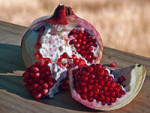
SAN DIEGO—Approaching Beth Jacob Congregation, the first thing most people notice is the unusual protrusion from the red roof. No matter what might have been intended by the architect, Synagogue Administrator Rand Levin says the story is told at the Orthodox synagogue that it represents the stem of a pomegranate, which is a fruit rich in symbolism in the Jewish religion.
Traditionally, a pomegranate is eaten on Rosh Hashanah—its seeds representing the fruitfulness with which one hopes the New Year is imbued. According to tradition, there are 613 seeds inside the pomegranate, exactly the same as the number of commandments, or mitzvoth, contained in the Torah.
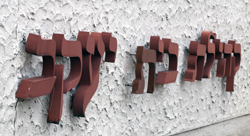
In Levin’s view, the seeds of a pomegranate represent “all the various people inside. Not one, but many, bringing a sweetness to the congregation.”
Both on the inside and the outside, the walls of the synagogue are heavily textured, representing those times when Jews “wail and cry when we pray,” he said.
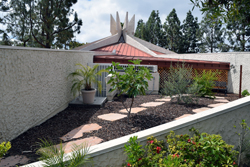
Triangular patches of ground provide areas for contemplation, recreation, and in the case of the Israel garden, more symbolism. Here are grown a real pomegranate tree, as well as a fig tree, olive tree, palm tree, and grapes – five of the seven species of Israel. “The only things we are missing are wheat and barley,” said Levin. “It has become a real serenity garden, if you will. People can sit here and schmooze.”
On another patch of ground is a small playground, providing a place of recreation for young and old throughout the week.
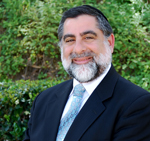
At the helm of Beth Jacob Congregation is Rabbi Avram Bogopulsky, only the third rabbi to serve there since it became an Orthodox institution after World War II. Beth Jacob Congregation and Center had been founded as a Conservative congregation in the late 1930s, but switched affiliations at the same time that the older Tifereth Israel Synagogue moved from the Orthodox to the Conservative movement.
Rabbi Baruch Stern, a survivor of the Holocaust who had trained as a Sunday school teacher at Tifereth Israel Synagogue during its Orthodox period, in 1947 became the first Orthodox rabbi of Beth Jacob. Up to his retirement in 1977, he permitted some of the congregation’s previous customs to continue, such as mixed seating. Rabbi Stern’s retirement coincided with the congregation’s move from a building on 30th Street in the North Park neighborhood of San Diego to its present location at 4855 College Avenue.
The next to lead the congregation was Rabbi Eliezer Langer, who had mechitzahs installed in the new building to conform Beth Jacob with contemporary Orthodox practice. After he accepted an assignment in Israel, he was succeeded in 1996 by Rabbi Bogopulsky.
En route to ordination, Rabbi Bogopulsky studied under Rabbi Berel Wein and Rabbi Laibel Reznick at the Yeshiva Shaarei Torah in Monsey, New York. According to the congregation’s website, “it was the inspirational words and messages of Rabbi Wein that instilled with Rabbi Bogopulsky a desire to be of service to Klal Yisrael.”
Today, Rabbi Bogopulsky is aided by rabbinical assistant Pinchas (“Pinny”) Roth, who coordinates the educational component of the synagogue, specifically the Monday night “Partners in Torah” program in which a teacher and student are paired.
Other staff members include Yisroel and Malka Weiser, who lead the youth programs. Both also teach at Soille San Diego Hebrew Day School, Yisroel in fact being the son of the Jewish day school’s headmaster, Rabbi Simcha Weiser.
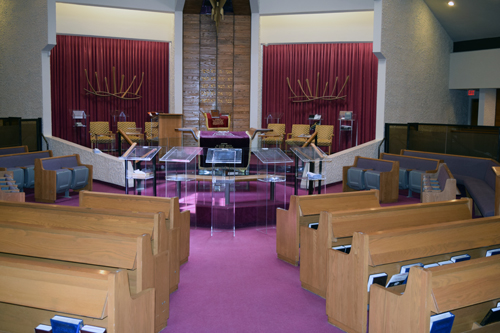
The Steiman Sanctuary, named posthumously for philanthropists Morrie and Barbara Steiman, seats 300 people with men in the middle and women on the two sides. As one might expect, the sanctuary is also rich in symbolism.
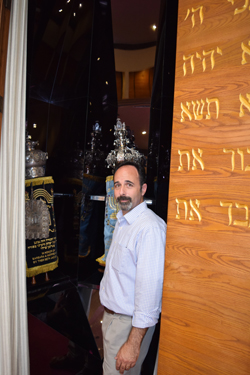
Upon the Aron Kodesh (Holy Ark) are engraved representations of the Ten Commandments, and when the doors are folded open to reveal the Torahs inside, the Ten Commandments appear on the fold-out sides of the doors as well, so that these words of God are always before the congregation.
Concerning the Ner Tamid, or Eternal Flame, “there is a legend that the glass ball at the top, which is visible, is attached to a motor that turns it to give the effect of a flame when light hits it,” Levin said. “I’m not sure if it true, we’ve never taken it apart to find the motor, but it was put here in 1977.”
On the walls on either side of the Holy Ark are large, matching, seven-branched menorahs. They were fashioned for the congregation after an electrical fire in a back room destroyed a wall of the sanctuary but not before Rabbi Langer and congregants were able to whisk the Torahs to safety.
Across from the Holy Ark is the Shulchan (or reader’s table) at which prayer leaders stand to recite prayers and read the Torah. The prayer leaders, like the congregation, face East during prayers. Reading stands, known as shtenders, enable congregants located at the front of the sanctuary to keep their siddurim (prayer books) and Chumashim (Bibles) within easy reach.
In the back of the room, paneled walls can open to enlarge the sanctuary for High Holy Day services and other occasions attended by larger-than-normal crowds. Otherwise these overflow spaces can be used for a variety of purposes, such as for study and rehearsals.
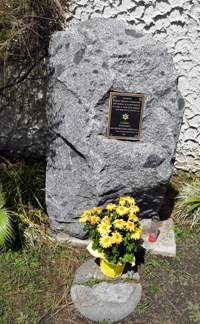
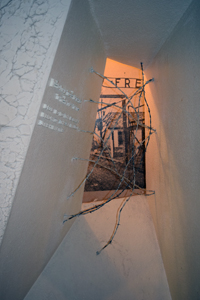
Both inside and outside, there are small memorials. One inside a wall niche is a photograph of the entrance to a concentration camp, with barbed wire in front of the photograph conveying some of the terror. In a garden, there is also a memorial erected by Russian-speaking members of the congregation to those who were lost in World War II.
Another important room in the Beth Jacob complex is the beit midrash, a study hall that also is used by daily minyans for prayer services. Along the back wall are four stained glass windows which, according to a description on the synagogue’s website, “depict highlights from the Garden of Eden, Exodus from Egypt, building the Holy Temple, its destruction, the return and rebuilding of Israel.”
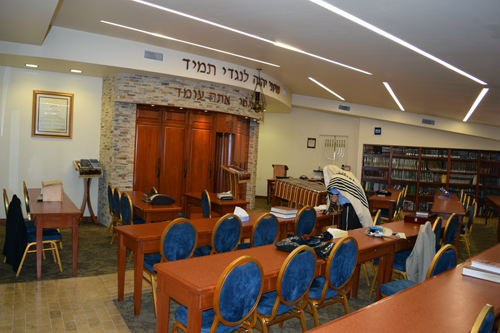
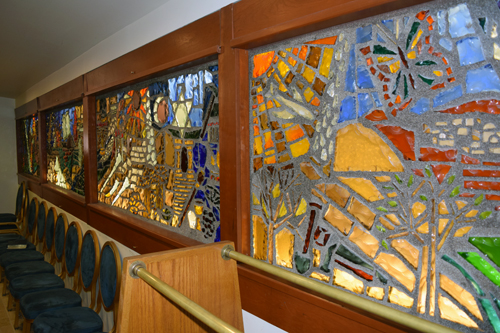
History and modernity, spirituality and pragmatism, exist side by side at Beth Jacob Congregation and Center, at which secular enterprises help to support a flourishing observant community that Levin estimates at 125 family units, with at least another 25 non-member families. “We don’t just service members, we service the entire Jewish community,” said Levin. “We hope those whom we serve who are not yet members someday will be.”
On the other side of the entrance foyer from the sanctuary is a large social hall, which is served by Beth Jacob’s own kosher kitchen. Approved kosher caterers are permitted to rent the kitchen, providing the synagogue another revenue stream. Rabbi Bogopulsky serves as the mashgiach for these uses.
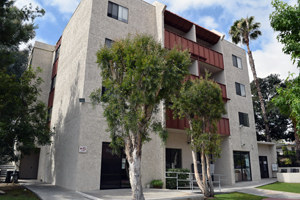
Having greater impact as a revenue source is a block of 50 apartments on the grounds of the Beth Jacob campus, which are rented not only to congregants wanting to be within an easy walk of services, but also to college students studying at nearby San Diego State University, and other occupants.
Levin said the apartments are “open to the public. We don’t discriminate, so there are many from the general population. It happens that about half the tenants have some connection to the synagogue, but we have Jews and non-Jews alike. It is a very diverse community.”
I asked if tenants can prepare non-kosher food.
“Absolutely,” he responded. “In the privacy of their own homes they can do what they want.”
For 14 years, Levin was a video journalist for KNSD, covering various news assignments in addition to serving as a co-producer for Ken Kramer’s popular “About San Diego” series, which also aired on the Public Broadcasting station, KPBS. After layoffs hit KNSD, Levin worked 4 ½ years for himself as a freelance video journalist, during which time he also served as the lay president of Beth Jacob Congregation.
“While I was president, I didn’t realize that I was training for my new career” as the synagogue’s administrator, he said.
As a boy, Levin had attended an Orthodox Day School and a Yeshiva in Los Angeles for one year, then completed his education at a public high school and at San Diego State University. His mother’s family was Orthodox, while his father was secular, he said.
“I moved to this community in 1998 and every day has been a day of spiritual growth for me,” said Levin.
*
Next: Lake Murray
*
Harrison is editor of San Diego Jewish World. He may be contacted via donald.harrison@sdjewishworld.com,